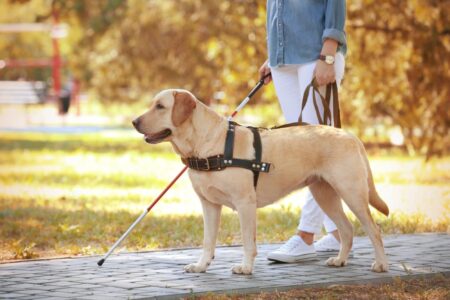How Often Should You Walk Your Dog?
Walking is an essential part of a dog’s daily routine and plays a crucial role in their physical and mental well-being. It is recommended that dogs are taken for a walk at least once a day, but the frequency and duration of walks can vary based on a few factors such as the age, breed, and overall health of the dog.
Some dog breeds, such as high-energy working breeds like Border Collies or Huskies, may require more frequent walks to release their excess energy. On the other hand, smaller breeds or older dogs may not need as much exercise and can be adequately exercised with less frequent walks.
Puppies and young dogs also have different exercise needs compared to adult and senior dogs. Puppies have a lot of energy and need regular walks for physical development and socialization. As they mature, their exercise needs will change, and they may require longer walks or other forms of activity.
Another factor to consider is the overall health of the dog. If a dog has health issues such as arthritis or joint problems, they may not be able to handle long walks and may need shorter and more frequent walks.
In addition to physical exercise, walks also provide mental stimulation for dogs. Exploring new scents, sights, and sounds can help keep their minds active and prevent boredom. As a result, it is important to tailor the frequency and duration of walks to meet the needs of each dog.
How Often Should You Walk Your Dog?
The frequency of walks for dogs can vary depending on their age, breed, and overall health. Generally, most dogs should be walked at least once a day for 30 minutes to an hour. High-energy breeds, such as border collies or golden retrievers, may require more frequent or longer walks.
Puppies and senior dogs may need more frequent, shorter walks due to their lower energy levels. It is important to consult with your veterinarian to determine the appropriate exercise routine for your dog.
When Is It Safe to Walk a Puppy?
It is generally safe to start walking a puppy once they have completed their initial vaccinations, typically around 10-12 weeks old. However, it is important to consult with your veterinarian before starting any kind of exercise routine with your puppy. They can advise you on the specific vaccination schedule and any potential health concerns for your particular puppy.
In the meantime, you can begin teaching your puppy basic leash manners and manners such as sitting and waiting before crossing the street. This will help them be better prepared for walks once they can go outside. You can also start socializing them with other friendly dogs and people in controlled environments, such as a puppy class or a friend’s house, to help them become comfortable with different sights, sounds, and smells.
Specific Factors Determining How Often to Walk a Dog
- Breed: The breed of your dog can play a significant role in determining how often they need to be walked. High-energy breeds such as herding and working dogs may require more frequent walks than low-energy breeds such as toy or lap dogs.
- Age: A dog’s age can also affect their exercise needs. Puppies and young dogs generally have more energy and will need to be walked more often. Senior dogs may need shorter, more leisurely walks but may still benefit from daily exercise.
- Size: The size of your dog can also impact their walking needs. Larger dogs may have more energy and require longer walks to meet their exercise needs, while smaller dogs may be content with shorter walks.
- Health and Fitness: A dog’s overall health and fitness level can affect how often they should be walked. If your dog is overweight or has any health conditions, they may need to be walked more frequently but for shorter amounts of time.
- Living Environment: Your living environment can also play a role in how often your dog should be walked. If you live in an apartment or have a small yard, your dog may need to be walked more often to meet their exercise needs. Dogs who have access to a larger outdoor space may be able to get their exercise through play and activity in their yard.
- Daily Routine: Your daily routine and schedule can also determine how often your dog should be walked. If you work long hours or have an unpredictable schedule, you may need to hire a dog walker or invest in doggy daycare to ensure your dog gets enough exercise.
- Individual Needs: Every dog is unique and may have different exercise needs based on their personality, behavior, and preferences. Pay attention to your dog’s energy levels and behavior to determine how often they need to be walked to stay happy and healthy.
How Often Should I Walk My Dog to Pee?
It is recommended to take your dog for a walk and bathroom break at least 3-4 times a day, about every 6-8 hours. However, this can vary depending on your dog’s age, breed, and overall health. Some dogs may need to go out more frequently, while others may be able to hold it for longer periods. It’s important to pay attention to your dog’s individual needs and establish a consistent routine for bathroom breaks. Your dog may also let you know when they need to go out by exhibiting certain behaviors, such as pacing or whining. Ultimately, it’s important to provide your dog with opportunities to relieve themselves regularly throughout the day to maintain good bladder and bowel health.
How Often Should You Walk Your Dog to Potty?
Most dogs should be taken out to potty at least three to four times a day, depending on their age, bladder control, and activity level. Puppies and older dogs may need more frequent potty breaks, while some adult dogs may be comfortable going only two or three times a day. It’s important to establish a consistent routine for your dog’s potty breaks and to pay attention to their individual needs.
Here are some general guidelines for how often you should walk your dog to the potty:
Puppies:
Puppies have smaller bladders and less bladder control, so they may need to go potty as often as every 1-2 hours. It’s important to take them out first thing in the morning, after meals, and before bedtime, as well as whenever they show signs of needing to go (sniffing, circling, etc.). As they get older, they will be able to hold it for longer periods.
Adult Dogs:
Most adult dogs can go potty every 4-6 hours, but again, this will vary based on their individual needs. Some adult dogs may need to go out more frequently, especially if they have health issues or are very active. It’s important to establish a consistent walking schedule for your adult dog.
SEE ALSO: Can Cats Be Vegan?
How Many Times Should You Walk Your Dog a Week?
The frequency of walks for a dog depends on its breed, age, and needs. In general, most dogs should be walked 3 to 4 hours a week. However, some breeds may require more physical activity and may need to be walked twice a day or even more frequently. Puppies and senior dogs may also require more frequent walks for their specific health and energy levels. It is important to consult with a veterinarian to determine the appropriate amount of walks for your specific dog.
What Time Should I Walk My Dog At Night?
The best time to walk your dog at night will depend on your schedule and your dog’s needs.
5 Reasons Why Dogs Need Walks
- Physical exercise: Dogs need regular physical activity to maintain their health and well-being. Walking is a great way to provide this exercise, as it allows them to stretch their muscles, get their heart rate up, and burn off excess energy. Regular walks also help to prevent obesity and other health issues that can arise from a lack of exercise.
- Mental stimulation: Along with physical exercise, walks also provide important mental stimulation for dogs. They get to experience new sights, sounds, and smells, which helps to keep their minds active and engaged. It can also prevent boredom, frustration, and destructive behaviors that may result from a lack of mental stimulation.
- Socialization: Walking a dog is also an excellent way to provide them with socialization opportunities. Dogs are social animals and benefit from interacting with other dogs, humans, and the outside world. Going for walks allows them to meet and interact with new people and animals, which helps to keep them well-adjusted and comfortable in different social situations.
- Supports potty training: Regular walks are an essential part of potty training a dog. Taking them out for walks at consistent times each day helps them develop a regular bathroom routine and learn where it is appropriate to go to the bathroom. This also helps to prevent accidents inside the house.
- Bonding with the owner: Going for walks with your dog is a great way to strengthen the bond between you and your furry companion. It gives you quality one-on-one time together, allows for communication and trust-building, and strengthens the relationship between you. It also provides an opportunity for training and reinforcing positive behaviors.
What Happens If You Don’t Walk Your Dog?
As a devoted pet owner, you likely understand the importance of daily walks for your dog’s physical and mental health. Not only does walking provide necessary exercise, but it also allows your dog to explore their surroundings, socialize with other dogs, and relieve themselves.
But what happens if you skip a few walks or stop walking your dog altogether? The consequences may be more significant than you think. Here are some of the potential effects of not walking your dog regularly.
- Weight Gain and Health Issues: Just like humans, dogs require regular exercise to maintain a healthy weight and prevent health issues such as obesity, heart disease, and joint problems. If your dog is not getting enough physical activity, they may become overweight or obese, which can lead to a variety of health problems.
- Behavioral Issues: A lack of physical activity can also lead to behavioral issues in dogs. Dogs who do not get enough exercise may become restless, anxious, bored, or even aggressive. This can manifest in destructive behaviors such as chewing, digging, or barking excessively. Regular walks also provide mental stimulation for dogs, which is essential for their overall well-being. Without this stimulation, dogs may become bored or frustrated, leading to behavioral issues.
- Toilet Accidents: Walking also provides dogs with the opportunity to relieve themselves. Without regular walks, your dog may have accidents inside the house, which can be frustrating for you and uncomfortable for your dog.
- Decreased Quality of Life: Dogs are social creatures and need regular interaction with other dogs and people. Walking provides socialization opportunities for dogs, allowing them to meet and play with other dogs, which is essential for their mental and emotional health. Without regular walks, your dog may become isolated, which can lead to a decreased quality of life.
- Negative Impact on Your Dog’s Mental Health: Dogs are naturally active animals, and regular walks allow them to release their pent-up energy and explore their surroundings. Without this outlet, dogs may become depressed or frustrated, which can hurt their mental health.
- Trust and Bonding: Regular walks also provide an opportunity for you to bond with your dog and strengthen your relationship. Skipping walks or not walking your dog regularly can affect the trust and bond you have with your dog.
FAQs
Q. Is 2 walks a day enough for a dog?
A. No, it is recommended that your dog be walked at least once a day for 30 minutes to an hour.
Q. Is it OK to not walk your dog every day?
A. No, it is not okay not to walk your dog every day as it can lead to the health issues mentioned above.
Q. How long can a dog go without a walk?
A. A dog can go a day without walking but it is not recommended.
Q. What is the best time to walk a dog?
A. The best time to walk a day depends on your schedule and your dog’s needs.
Q. Can I walk my dog once a day?
A. Yes, you can walk your dog once a day.
Q. How long should you walk your dog?
A. It is recommended to walk your dog at least 30 minutes daily.
SEE ALSO: How to Get Your Dog Started in Flyball: Step-by-Step
Conclusion
In conclusion, the frequency and duration of walks for your dog will depend on their specific physical and mental needs. It is recommended to walk your dog at least twice a day for a total of 30 minutes to 1 hour, but this may vary depending on their breed, age, and health. It is important to observe your dog’s behavior and energy levels to determine their individual needs and adjust accordingly. Regular exercise, both physically and mentally, is essential for a happy and healthy dog. If you are unsure about how often you should walk your dog, consult with your veterinarian for personalized recommendations.

